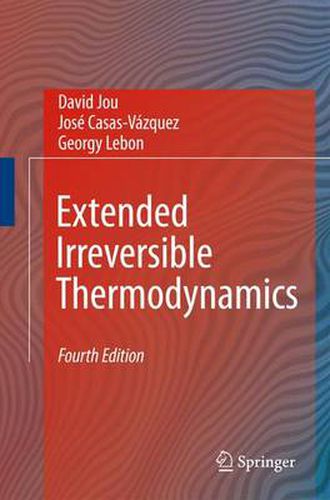Readings Newsletter
Become a Readings Member to make your shopping experience even easier.
Sign in or sign up for free!
You’re not far away from qualifying for FREE standard shipping within Australia
You’ve qualified for FREE standard shipping within Australia
The cart is loading…






This title is printed to order. This book may have been self-published. If so, we cannot guarantee the quality of the content. In the main most books will have gone through the editing process however some may not. We therefore suggest that you be aware of this before ordering this book. If in doubt check either the author or publisher’s details as we are unable to accept any returns unless they are faulty. Please contact us if you have any questions.
The fast progress in many areas of research related to non-equilibrium ther- dynamics has prompted us to write a fourth edition of this book. Like in the previous editions, our main concern is to open the subject to the widest au- ence, including students, teachers, and researchers in physics, chemistry, engine- ing, biology, and materials sciences. Our objective is to present a general view on several open problems arising in non-equilibrium situations, and to afford a wide perspective of applications illustrating their practical outcomes and con- quences. A better comprehension of the foundations is generally correlated to an increase of the range of applications, implying mutual feedback and cross fert- ization. Truly, thermodynamic methods are widely used in many areas of science but, surprisingly, the active dynamism of thermodynamics as a ?eld on its own is not suf?ciently perceived outside a relatively reduced number of specialized researchers. Extended irreversible thermodynamics (EIT) goes beyond the classical f- malisms based on the local equilibrium hypothesis; it was also referred to in an earlier publication by the authors (Lebon et al. 1992) as a thermodynamics of the third type, as it provides a bridge between classical irreversible thermodynamics and rational thermodynamics, enlarging at the same time their respective range of application. The salient feature of the theory is that the ?uxes are incorporated into the set of basic variables.
$9.00 standard shipping within Australia
FREE standard shipping within Australia for orders over $100.00
Express & International shipping calculated at checkout
This title is printed to order. This book may have been self-published. If so, we cannot guarantee the quality of the content. In the main most books will have gone through the editing process however some may not. We therefore suggest that you be aware of this before ordering this book. If in doubt check either the author or publisher’s details as we are unable to accept any returns unless they are faulty. Please contact us if you have any questions.
The fast progress in many areas of research related to non-equilibrium ther- dynamics has prompted us to write a fourth edition of this book. Like in the previous editions, our main concern is to open the subject to the widest au- ence, including students, teachers, and researchers in physics, chemistry, engine- ing, biology, and materials sciences. Our objective is to present a general view on several open problems arising in non-equilibrium situations, and to afford a wide perspective of applications illustrating their practical outcomes and con- quences. A better comprehension of the foundations is generally correlated to an increase of the range of applications, implying mutual feedback and cross fert- ization. Truly, thermodynamic methods are widely used in many areas of science but, surprisingly, the active dynamism of thermodynamics as a ?eld on its own is not suf?ciently perceived outside a relatively reduced number of specialized researchers. Extended irreversible thermodynamics (EIT) goes beyond the classical f- malisms based on the local equilibrium hypothesis; it was also referred to in an earlier publication by the authors (Lebon et al. 1992) as a thermodynamics of the third type, as it provides a bridge between classical irreversible thermodynamics and rational thermodynamics, enlarging at the same time their respective range of application. The salient feature of the theory is that the ?uxes are incorporated into the set of basic variables.